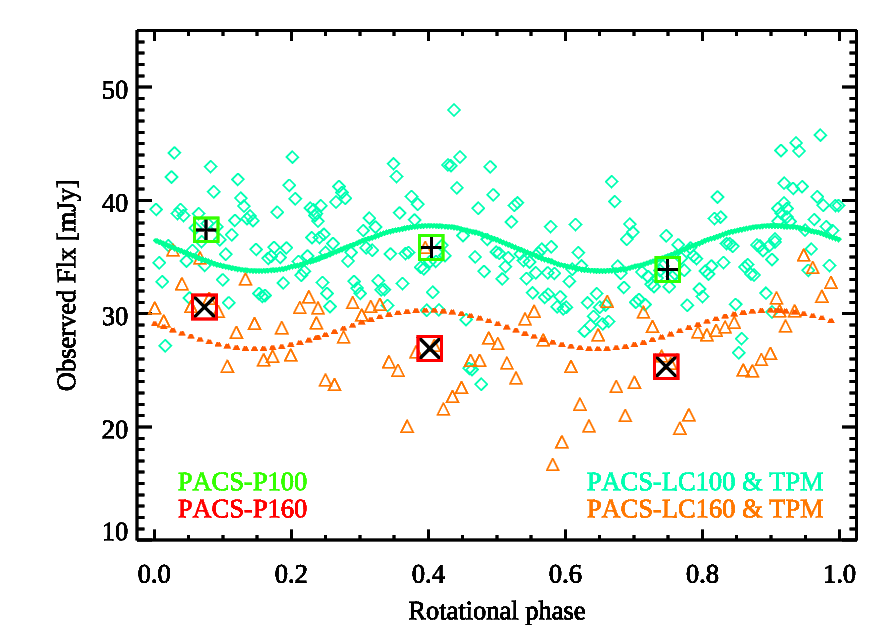The visible and thermal light curve of the large Kuiper belt object (50000) Quaoar
- 1HUN-REN CSFK, Research Center for Astronomy and Earth Sciences, Konkoly Observatory, Budapest, Hungary (pkisscs@konkoly.hu)
- 2CSFK, MTA Centre of Excellence, Budapest, Hungary
- 3ELTE Eötvös University, Institute of Physics and Astronomy, Budapest, Hungary
- 4Max-Planck-Institut für extraterrestrische Physik, Garching, Germany
- 5Max-Planck-Institut für Sonnensystemforschung, Göttingen, Germany
- 6Instituto de Astrofísica de Andalucía, IAA-CSIC, Granada, Spain
- 7Florida Space Institute, UCF, Orlando, USA
Recent stellar occultations have allowed accurate instantaneous size and apparent shape determinations of the large Kuiper belt object (50000) Quaoar and the detection of two rings with spatially variable optical depths. Here we present new visible range light curve data of Quaoar from the Kepler/K2 mission, and thermal light curves at 100 and 160 µm obtained with Herschel/PACS. The K2 data provide a single-peaked period of 8.88 h, very close to the previously determined 8.84 h, and it favours an asymmetric double-peaked light curve with a 17.76 h period. We clearly detected a thermal light curve with relative amplitudes of ~10% at 100 and at 160 µm. A detailed thermophysical modelling of the system shows that the measurements can be best fit with a triaxial ellipsoid shape, a volume-equivalent diameter of 1090 km, and axis ratios of a/b = 1.19 and b/c = 1.16. This shape matches the published occultation shape, as well as visual and thermal light curve data. The radiometric size uncertainty remains relatively large (±40 km) as the ring and satellite contributions to the system-integrated flux densities are unknown. In the less likely case of negligible ring or satellite contributions, Quaoar would have a size above 1100 km and a thermal inertia ≤ 10 J m−2K−1s−1/2. A large and dark Weywot in combination with a possible ring contribution would lead to a size below 1080 km in combination with a thermal inertia ≳10 J m−2K−1s−1/2, notably higher than that of smaller Kuiper belt objects with similar albedo and colours. We find that Quaoar's density is in the range 1.67-1.77 g cm−3, significantly lower than previous estimates. This density value closely matches the relationship observed between the size and density of the largest Kuiper belt objects.

Figure 1: Thermophysical model results for Quaoar. Left: All available IR observations divided by the corresponding TPM predictions, using a triaxial shape with an equivalent diameter of 1090 km, and a thermal inertia of 12 J m−2K−1s−1/2 . The calculations take small flux contributions from the ring and Weywot into account. These absolute ratios are very sensitive to the size and thermal inertia assumptions in the model, the 24 μm points is strongly influenced by surface roughness effects. Right: Far-infrared light curves. The small ring and Weywot flux contributions are subtracted from the observed PACS 100 and 160 μm lightcurve data. The triaxial Quaoar model solutions (at 100 μm in green and at 160 μm in orange) are shown on top. The boxes represent the mean PACS values.
How to cite: Kiss, C., Müller, T., Marton, G., Szakáts, R., Pál, A., Molnár, L., Vilenius, E., Rengel, M., Ortiz, J.-L., and Fernandez-Valenzuela, E.: The visible and thermal light curve of the large Kuiper belt object (50000) Quaoar, Europlanet Science Congress 2024, Berlin, Germany, 8–13 Sep 2024, EPSC2024-104, https://doi.org/10.5194/epsc2024-104, 2024.